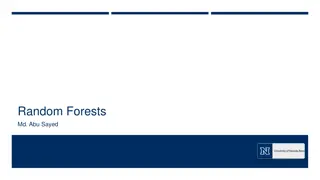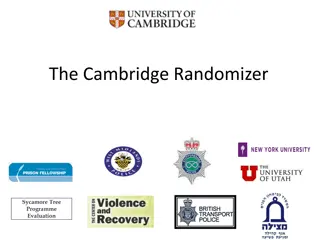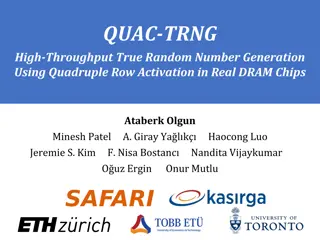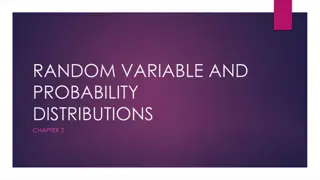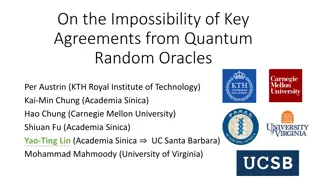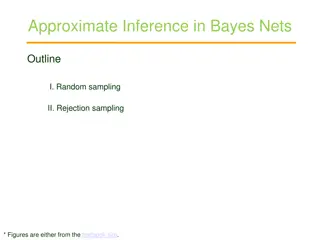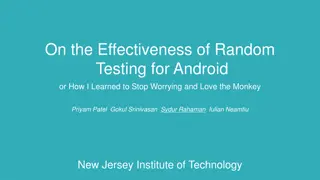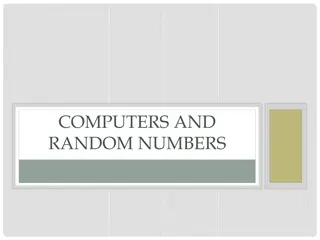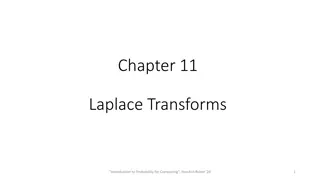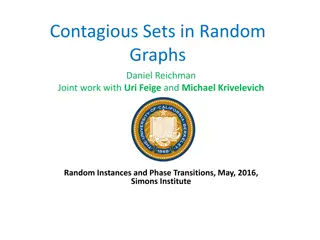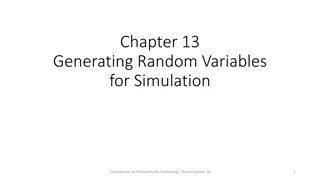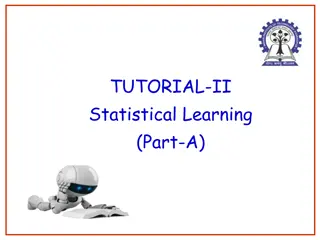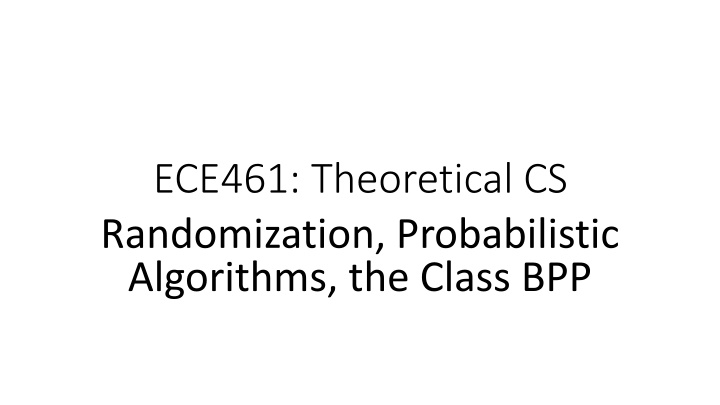
Overview of ECE461 Theoretical Computer Science Randomization & Probabilistic Algorithms
Explore the concepts covered in ECE461, including computability theory, complexity theory, and the introduction of probabilistic Turing machines. Learn how randomization may enhance algorithm efficiency and tackle problems that are difficult to solve deterministically.
Download Presentation

Please find below an Image/Link to download the presentation.
The content on the website is provided AS IS for your information and personal use only. It may not be sold, licensed, or shared on other websites without obtaining consent from the author. If you encounter any issues during the download, it is possible that the publisher has removed the file from their server.
You are allowed to download the files provided on this website for personal or commercial use, subject to the condition that they are used lawfully. All files are the property of their respective owners.
The content on the website is provided AS IS for your information and personal use only. It may not be sold, licensed, or shared on other websites without obtaining consent from the author.
E N D
Presentation Transcript
ECE461: Theoretical CS Randomization, Probabilistic Algorithms, the Class BPP
Brief Recap Earlier in the course, we discussed topics related to computability theory, which relates to the question of which languages are decidable Our primary models of computation have been deterministic Turing machines (DTMs) and nondeterministic Turing machines (NTMs) If we accept the Church-Turing thesis, all algorithms can be implemented by Turing machines We have learned that computation is inherently limited, and that some languages are undecidable Then we started to cover complexity theory, which explores which languages can be decided efficiently We introduced time and space complexity classes; two important time complexity classes are P P and NP which are believed to be different, but the P P versus NP NPquestion has never been solved We also learned that some languages are intractable; we know that they require exponential time, and in some cases exponential space, to solve them The NP NP-complete problems are probably intractable, but we don't know for sure In this topic, based on Section 10.2 of the book, we will consider Turing machines with the added ability to rely on randomization We will consider whether randomization might allow TMs so solve some problems efficiently (with some small probability of error) that cannot be solved efficiently without randomization NP,
Probabilistic Turing Machines Book: "A probabilistic algorithm is an algorithm designed to use the outcome of a random process." (I slightly modified the formatting) The book compares such a random process to flipping a coin The book briefly discusses why randomness intuitively might be helpful for creating efficient algorithms (we will discuss this later in the topic) Definition 10.3 defines the concept of a probabilistic Turing machine; I have copy/pasted the definition from the book to the next slide, since it is long, and I want to keep the book's exact wording The definition states that a probabilistic Turing machine is "a type of nondeterministic Turing machine", but I would claim it is nondeterministic in a different sense than the NTMs we have discussed before (I will discuss this in class) The definition involves a coin-flip step, and includes a formula for Pr[b], the probability of some branch, b, of the computation, which is based on the number of coin flips used in the branch Although it is not explicitly stated, the definition assumes it is a fair coin (i.e., each outcome has a probability of 0.5) Also unexplained is that repeated coin flips can be used to produce random values with other distributions Definition 10.3 also includes the formula for the probability that a probabilistic TM, M, accepts its input, w The book also states that Pr[M rejects w] = 1 Pr[M accepts w] This seems to assume that the probabilistic TM always halts, which is not part of the definition, and based on other sources, it is not true of probabilistic TMs in general However, in this topic, we will only consider polynomial time probabilistic algorithms that are guaranteed to halt
Error Probability Given the same input, w, a probabilistic TM, M, might sometimes accept w and sometimes reject w, depending on the coin flips In general, M might never halt, but we will only consider algorithms that always halt (although the book does not explicitly state this) Book: "When a probabilistic Turing machine decides a language, it must accept all strings in the language and reject all strings out of the language as usual, except that now we allow the machine a small probability of error" Note that if a Turing machine "decides a language", it must always either accept or reject its input (always halt) When we apply a probabilistic Turing machine that decides a language, there is a chance it will make an error The book defines the concept of the error probability, , of a probabilistic Turing machine as follows (I am keeping the book's exact wording): For 0 < , we say that M decides language A with error probability if 1. w A implies Pr[M accepts w] 1 , and 2. w A implies Pr[M rejects w] 1 . We may also consider error probabilities that depend on the length of the input; e.g., we might consider = 2-n, where n is the length of w
BPP Now, we are going to introduce a new complexity class Definition 10.4 states: "BPP BPP is the class of languages that are decided by probabilistic polynomial time Turing machines with an error probability of ." Note that for any language in BPP, there is a TM that decides it with an error probability, , that is at most That means that the TM is allowed to make mistakes in either direction, but at most of the time, for both directions The book then explains a very important fact; the constant, , is arbitrary, but it doesn't really matter Important: The membership in BPP would not change if we modify the definition to specify any other constant for the error probability that is strictly between 0 and For example, if we have a probabilistic TM to decide a language with error probability , and we want one with error probability 2-100, we can construct it This is due to the amplification lemma (we will discuss this next)
The Amplification Lemma Lemma 10.5, the amplification lemma, states (I am keeping the book's exact wording): Let be a fixed constant strictly between 0 and . Then for any polynomial p(n), a probabilistic polynomial time Turing machine M1that operates with error probability has an equivalent probabilistic polynomial time Turing machine M2that operates with an error probability of 2 p(n). Here, p(n) could be replaced by any positive constant above 1 of our choice, or it could be a polynomial function of n, where n is the length of the input The basic idea is that we could reapply M1as many times as we want, and then only accept the input if M1accepts it a majority of times If we run M1enough times, the probability of it erroneously accepting or rejecting w at least half of the times becomes exponentially small To save time, we won't step through the book's proof (which is simple conceptually, but I had to verify certain steps using additional algebra); here are the high-level details: Suppose we are given a TM, M1, with error probability for some language, L We want to construct a TM, M2, for L with error probability 2-t, where t can be a polynomial function of n M2can run 2k simulations of M1on w, where k t/ , and = -log2(4 (1- )), accepting w if and only if a majority of the simulations accept w The book proves that this is sufficient for guaranteeing the desired probability bound
Probabilistic Primality Testing (part 1) Our textbook describes a probabilistic algorithm for determining whether a number is prime (otherwise, it is composite); this task is known as primality testing Based on other sources, I believe the algorithm described in the book is known as the Miller- Rabin primality test Miller first discovered a deterministic version in 1976, but it is based on an unproven hypothesis Rabin developed the probabilistic version in 1980 Note that the Miller-Rabin method was discovered decades before PRIMES was shown to be in P As mentioned in a previous topic, this was proven in 2002 by Agrawal, Kayal, and Saxena; their revised publication, dated 2004, is called "PRIMES is in P" This proof came as a surprise to computer scientists, many of whom had expected PRIMES was not in P before this proof We will sketch out the probabilistic primality testing algorithm, but we will not cover all the details that are in the textbook The textbook spends about 4.5 pages on this algorithm, including the proof of relevant theorems and lemmas I personally find the proof of the error probability of the algorithm to be confusing; it relies heavily on results from number theory that are assumed without being fully explained The description in the book culminates in Theorem 10.9, which states: "PRIMES BPP."
Probabilistic Primality Testing (part 2) The algorithm we will cover relies on Fermat's little theorem, stated as Theorem 10.6 in the book Theorem 10.6 states: "If p is prime and a p In the theorem, p The book does not prove this theorem (Problem 10.15, at the end of the chapter, challenges you to prove it) To help explain Fermat's little theorem, the book shows two examples First, when p = 7 and a = 2, we see that 2(7-1)= 64, and 64 mod 7 = 1 Second, when p = 6 (not prime) and a = 2, we see that 2(6-1)= 32, and 32 mod 6 = 2 (the theorem does not apply because p is not prime) Therefore, one way to check if a number, p, might be prime is to randomly choose a number, a, between 1 and p-1, and check whether ap-1 1 (mod p); we will refer to this as a Fermat test Note that when p is not prime, the remainder might be 1 (meaning p passes the test), but it is not guaranteed It turns out that there are some composite numbers called Carmichael numbers, which pass all the tests Based on other sources, there are infinitely many Carmichael numbers, but they are significantly rarer than prime numbers It is known that, for any p that is neither prime nor a Carmichael number, the Fermat test will fail with probability at least Note that we can't just apply all the tests, because that would require exponential time with respect to the length of the encoding of p +, then ap-1 1 (mod p)." += {1, 2, , p-1}
Probabilistic Primality Testing (part 3) We will call a number pseudoprime if it is either prime or if it is a Carmichael number We will first present a polynomial time probabilistic algorithm called PSEUDOPRIME that detects if a number if is pseudoprime We will then discuss (at a high level) how it can be expanded to detect if a number is prime In both cases, the algorithm will have a small error probability PSEUDOPRIME processes its input, p, a number that might be pseudoprime, as follows (I'm keeping the book's exact wording, but slightly modifying the formatting): 1. Select a1, , akrandomly in p 2. Compute ai 3. If all computed values are 1, accept; otherwise, reject. If p is pseudoprime, the algorithm will accept it with certainty If p is not pseudoprime, the algorithm might erroneously accept it, with a probability at most 2-k Recall that, except for the Carmichael number which pass all the Fermat tests, all other composite numbers fail at least half of the Fermat tests (this was mentioned on the previous slide) +. p 1mod p for each i.
Probabilistic Primality Testing (part 4) To distinguish the primes from the pseudoprimes, the textbook introduces another test based on another fact from number theory about primes Book: "The underlying principle is that the number 1 has exactly two square roots, 1 and -1, modulo any prime p" The book continues: "For many composite numbers, including all the Carmichael numbers, 1 has four or more square roots." Neither of these fats are proven in the book, but they offer an example of what it means to have more than two square roots of 1 modulo a composite number They point out that 1, -1, 8, and -8 are all square roots of 1, modulo 21; note that 21 is not a Carmichael number (based on other sources, the smallest is 561), but it is composite They remind us that if a number, a, passes the Fermat test, it means that ap-1 1 (mod p) Therefore, a(p-1)/2is a square root of 1 modulo p If the remainder is still 1, we can divide the exponent by 2 again, to get another square root of p The book uses this fact to expand the algorithm, roughly speaking, as follows: First, for a given input, p, it randomly selects various values for a, as previously explained, and applies the Fermat test; the algorithm rejects if any of these tests fails (since the number is not pseudoprime) If a passes the test, the algorithm uses a to find multiple square roots of p and checks if any of them are not 1 or -1; if so, the algorithm rejects, since this means that the number must be a Carmichael number, not a prime If all the tests pass, the algorithm accepts (but there is a small degree of error) The book goes into much greater detail, and the proof of the error probabilities is complicated
RP The existence of the probabilistic algorithm to detect primes, together with the proof of the error probability, proves Theorem 10.9 Recall that Theorem 10.9 states: "PRIMES BPP." Note, however, that this algorithm has one-sided error That is, if a number p, is prime, it will definitely be accepted If a number is composite, there is a small chance of error This leads to the definition of another complexity class, known as RP Definition 10.10 states (I am keeping the book's exact wording): RP is the class of languages that are decided by probabilistic polynomial time Turing machines where inputs in the language are accepted with a probability of at least , and inputs not in the language are rejected with a probability of 1. The existence of the algorithm we have covered shows that COMPOSITES RP Of course, we know that both PRIMES and COMPOSITES are also in P (remember that deterministic classes are closed under complementation) RP
Read-Once Branching Programs A branching program is a directed acyclic graph where nodes represent Boolean variables and outgoing edges represent their values Most of the nodes (all except two) are called query nodes; each query node is labeled with a Boolean variable Each query nodes has two outgoing edges labeled 0 and 1, representing the possible values of the variable The two special nodes that are not query nodes are called output nodes; those have no outgoing edges One node is designated as the start node A branching program represents a Boolean function The value of the function can be determined by following the path according to the values of the variables The output is the label of the output node that is reached (which must happen, since there are no cycles) In Section 9.3 on circuit complexity (which we skipped this semester), the book shows that any language in P can be represented by a polynomial sized Boolean circuit In the current section (Section 10.2), the book claims that any language in L with a Boolean alphabet can be represented by a polynomial sized branching program A branching program in which each variable appears at most once on every path from the start node to an output node is called a read-once branching program Two examples of read-once branching programs are shown in the figure on the next slide
EQROBP(briefly) The textbook points out that determining if two general branching programs are equivalent is coNP-complete However, if we limit the task to read-once branching programs, there is a polynomial time probabilistic algorithm for achieving this Consider the language: EQROBP= {<B1, B2> | B1and B2are equivalent read-once branching programs} Theorem 10.13 states: "EQROBPis in BPP." We are not going to cover the probabilistic algorithm or the proof of its error probability (the details are in the book) What is interesting here is that EQROBPis not known to be in P Of course, that doesn't mean that EQROBPis not in P Recall that a polynomial time probabilistic algorithm was known for primality testing decades before the problem was known to be in P
Relations of BPP to Other Complexity Classes Most of the information on this slide is based on other sources Clearly, BPP = coBPP (because the required error probability is the same in both directions) Clearly, RP BPP (the definition of RP almost ensures inclusion in BPP directly, but the algorithm may have to be run twice so that the error probability in one direction is less than ) Clearly, P BPP, because languages in P have deciders with error probability 0 It is unknown whether BPP = P This is another important unsolved problem in theoretical computer science We have seen that there exist some languages that are known to be in BPP but are not known to be in P However, none of these languages have been proven to not be in P Other sources mention that it has been conjectured that BPP = P, but this has not been proven (the Arora and Barak book states that "today most researchers believe that BPP = P") Even if BPP = P, the probabilistic algorithms for some problems may be simpler and more efficient in practice The relation between BPP and NP is not known It is possible that BPP NP, that NP BPP, or neither Computer scientists consider it unlikely that NP BPP, because this would mean that there are efficient probabilistic algorithms for all NP-complete problems (albeit with non-zero, but very low, error probability)
Pseudorandomness At the end of the section, the textbook briefly (in one paragraph) discusses an important point related to probabilistic algorithms Book: "True randomness may be difficult (or impossible) to obtain, so it is usually simulated with pseudorandom generators" We know from DSA II that modern computers (and, more generally, Turing machines) are incapable of true randomness Pseudorandom generators can generate values that may have many desirable properties of random numbers, but they are generated using deterministic algorithms Whether or not this is good enough to ensure properties of probabilistic algorithms is not obvious Here are some facts stated in the paragraph: The book states, "Algorithms that are designed to use randomness may work equally well with these pseudorandom generators, but proving that they do is generally more difficult" Furthermore, "sometimes probabilistic algorithms may not work well with certain pseudorandom generators" Finally, "Sophisticated pseudorandom generators have been devised that produce results indistinguishable from truly random results by any test that operates in polynomial time, under the assumption that a one-way function exists" The book covers one-way functions in Section 10.6, on cryptography, but we will not cover this topic The Papadimitriou book and the Arora and Barak book discuss this issue in considerably more detail, but I have not read through all that material



